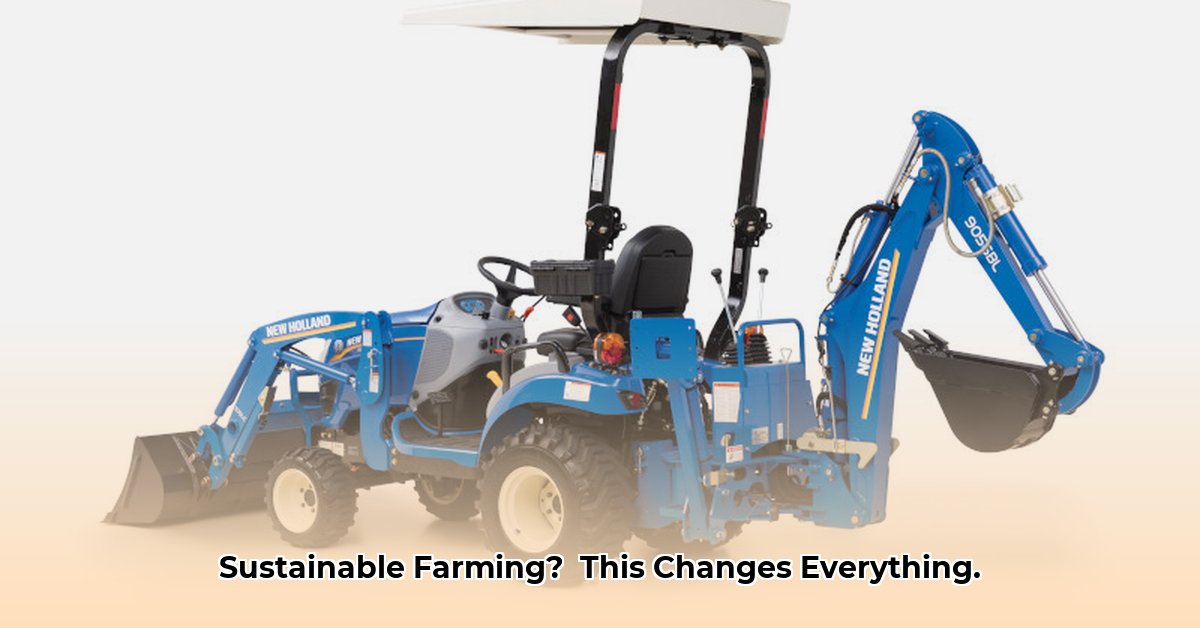
Choosing the right compact tractor with a loader and backhoe can significantly impact your farming operation's efficiency and sustainability. This guide helps you navigate the selection process, ensuring you choose the perfect machine for your specific needs. For more detailed information, check out this compact tractor guide.
Sizing Up Your Needs: Farm, Crops, and Budget
Before exploring models, assess your farm's size and intended use. A small orchard requires a less powerful machine than a large-scale vegetable operation. Crop type influences the need for gentle handling (delicate crops) versus rugged capability (sturdy crops). Soil conditions (rocky, clay, sandy) also dictate tractor robustness.
What tasks will the tractor perform? Material movement, post-hole digging, tilling? Diverse work requires a versatile machine. Finally, establish a realistic budget, considering the significant investment and potential financing options (loans, leases). Remember to factor in ongoing costs such as maintenance and fuel. Do you anticipate needing additional attachments in the future? This impacts your overall budget considerations.
Essential Features: Power and Attachments
Key features to consider include:
- Horsepower: Higher horsepower equates to greater power for heavier tasks but often increases fuel consumption. Determine the heaviest load you'll manage and select a suitable horsepower to comfortably handle it.
- Loader Capacity: Crucial for material handling. Consider your heaviest loads (hay bales, feed sacks) to ensure adequate lift capacity and reach for efficient, safe operation.
- Backhoe Digging Strength and Depth: Essential for digging, trenching and post-hole creation. Match the backhoe's specifications to the depth and difficulty of your typical jobs. Consider the backhoe reach for efficient operation in confined spaces.
- Transmission Type: Hydrostatic transmissions offer seamless speed and direction changes, ideal for beginners. Gear transmissions provide more precise control but demand more operator skill.
- Four-Wheel Drive (4WD): 4WD improves traction in hilly terrain or wet/muddy conditions, but adds to the cost. Consider your terrain and typical weather conditions.
- Rollover Protection Structure (ROPS): A critical safety feature protecting the operator in rollovers. Never operate a tractor without a securely installed ROPS.
- Power Take-Off (PTO): Powers attachments like tillers and mowers. Ensure sufficient PTO horsepower for your intended attachments. Are you likely to need any additional attachments in the long run?
Technology Integration: Smart Farming Tools
While not always essential, advanced technology boosts efficiency. GPS guidance and automated steering systems reduce overlaps, save time and resources, and reduce operator fatigue. However, the availability and cost vary across models. How essential are technologies like GPS for your operation? This depends on the specifics of your farm and your operational priorities.
Model Comparisons: Finding the Right Fit
Direct model comparisons require detailed specifications often scattered across manufacturer websites. The following table offers illustrative examples. Remember specifications vary significantly between brands and models. Always consult manufacturer specifications for the most up-to-date and accurate information.
| Feature | Model A | Model B | Model C | Considerations |
|---|---|---|---|---|
| Horsepower | 25 | 30 | 35 | More HP generally means greater power but higher fuel cost. |
| Loader Capacity (lbs) | 1000 | 1200 | 1500 | Match to the heaviest loads you'll be handling. |
| Backhoe Digging Depth (in) | 72 | 84 | 96 | Dependent on the tasks you need to perform. |
| Price (USD) | $20,000 | $25,000 | $30,000 | Consider your budget and financing options. |
| Warranty (Years) | 2 | 3 | 3 | Longer warranties offer more protection. |
| Fuel Efficiency (gal/hr) | Approximately 2 | Approximately 2.5 | Approximately 3 | Fuel economy is important for long-term operation. |
Maintenance and Safety: Long-Term Care and Safe Operation
Regular maintenance (refer to your owner’s manual for scheduling) such as oil changes, filter replacements, and fluid checks is crucial for longevity and prevents costly breakdowns. Always prioritize safety. Wear appropriate safety gear (safety glasses, gloves, etc.), follow operating instructions, and be aware of your surroundings. Never operate the tractor when fatigued or under the influence of alcohol or drugs.
Conclusion: Building a Sustainable Farming Future
Choosing a compact tractor is a substantial investment. By carefully weighing your farm's needs, researching models, and understanding key features, you can select a machine that efficiently supports your sustainable farming practices for years to come.
How to Compare Compact Tractor Fuel Efficiency and Maintenance Costs for Sustainable Farming
Key Takeaways:
- Farm size significantly influences tractor choice; smaller farms benefit from compact tractors’ fuel efficiency. Larger operations might find larger tractors more fuel-efficient per acre.
- Advanced technologies like GPS guidance significantly improve fuel efficiency.
- Transmission type (hydrostatic vs. gear) affects fuel economy; hydrostatic usually offers higher efficiency for variable loads and terrain.
- Initial investment versus long-term savings requires careful consideration; cheaper initial cost might lead to higher maintenance costs.
- Maintenance costs and repair times significantly affect operational efficiency, and these often differ between tractor types.
This section elaborates on fuel efficiency and maintenance, offering a more detailed approach to cost analysis. Remember that real-world fuel consumption varies greatly based on factors like terrain, usage patterns, and operator skill.